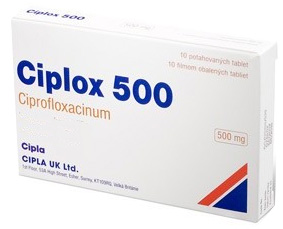Medication Overview
Ciplox is a brand-name antibiotic containing the active ingredient ciprofloxacin. It belongs to the fluoroquinolone class, commonly used to treat bacterial infections. It effectively targets gram-negative organisms and some gram-positive bacteria, making it versatile for various infections. Ciplox is often administered in both oral and intravenous forms, depending on the severity and location of the infection.
Mechanism of Action
Ciprofloxacin works by inhibiting bacterial DNA gyrase, an essential enzyme for DNA replication and repair. This interference disrupts the process of bacterial cell division, ultimately leading to cell death. The bactericidal action of Ciplox is concentration-dependent, meaning higher concentrations can enhance bacterial eradication. Its broad-spectrum activity allows it to treat different types of infections effectively.
Indications for Use
Ciplox is indicated for treating a variety of infections, including urinary tract infections (UTIs), respiratory tract infections, gastrointestinal infections, and skin infections. It is also utilized in managing certain types of bone and joint infections. Ciprofloxacin’s efficacy extends to combating infections caused by susceptible strains of bacteria, making it suitable for both community-acquired and hospital-acquired infections.
Dosage and Administration
The dosage of Ciplox varies depending on the type and severity of infection. For uncomplicated UTIs, a typical dosage might be 250-500 mg twice daily. In more severe infections, such as pneumonia, higher dosages of up to 750 mg twice daily may be required. Intravenous forms are used in hospital settings for serious infections. The duration of treatment generally ranges from 7 to 14 days, based on clinical response.
Pharmacokinetics Details
Ciprofloxacin is well absorbed following oral administration, with peak plasma concentrations reached within one to two hours. It has a bioavailability of approximately 70%, and its absorption can be delayed by food, although not significantly reduced. Ciplox is widely distributed throughout the body and predominantly excreted unchanged in urine. Its half-life is approximately four to six hours, allowing for twice-daily dosing in many cases.
Potential Drug Interactions
Ciplox can interact with various substances, leading to altered absorption or efficacy. Antacids containing magnesium or aluminum, and supplements with iron or zinc can decrease Ciprofloxacin absorption when taken concurrently. It may potentiate the effects of anticoagulants like warfarin, necessitating closer monitoring of INR levels. Concurrent use with theophylline can increase serum levels of theophylline, demanding attention due to potential toxicity.
Special Considerations
In patients with renal impairment, dose adjustments of Ciplox may be necessary due to reduced drug clearance. Elderly patients may also require modified dosing due to age-related renal function decline. Ciprofloxacin should be used cautiously in those with a history of tendon disorders related to fluoroquinolones. Additionally, robust monitoring of glucose levels is advised for diabetic patients, as hypoglycemia or hyperglycemia may occur.
Pregnancy and Lactation
The use of Ciplox during pregnancy is advised only if the benefits outweigh the risks, due to limited –though concerning– data on teratogenic effects. Ciprofloxacin is known to cross the placental barrier and may potentially harm the developing fetus. Breastfeeding mothers should either discontinue the drug or consider alternatives, as ciprofloxacin is excreted in breast milk and may affect the nursing infant adversely.
Pediatric Use Guidelines
Ciplox is generally not recommended for use in children due to potential bone and joint issues unless benefits outweigh risks, as in treating complicated UTIs or inhalational anthrax. Its impact on bone growth and cartilage in younger populations necessitates careful assessment by healthcare professionals before prescription. Lower doses are typically used, and close monitoring is mandatory during treatment.
Adverse Effects Profile
Common adverse effects of Ciplox include gastrointestinal disturbances such as nausea, diarrhea, and abdominal pain. Neurological symptoms like headaches, dizziness, or insomnia may also occur. Photosensitivity reactions are noted, advising patients to avoid excessive sunlight. Tendon rupture, although rare, is a serious concern, particularly among elderly patients or those on concurrent corticosteroid therapy.
Storage and Handling
Ciplox should be stored at room temperature, away from light and moisture. Solutions for IV infusion need to be protected from freezing and should not be used if precipitation occurs. Tablets and oral suspension should be kept in their original containers and tightly closed when not in use. Proper storage ensures the medication maintains its efficacy throughout its shelf life.
Treatment Monitoring Essentials
Regular monitoring during Ciplox therapy involves assessing infection resolution through clinical and laboratory evaluations. Kidney function tests may be imperative, especially in long-term therapy or in patients with existing renal issues. Liver enzymes should be monitored if elevated liver function tests are observed. Observation for side effects such as tendon pain or peripheral neuropathy is critical for early intervention.
Missed Dose Instructions
If a dose of Ciplox is missed, it should be taken as soon as remembered, unless it is close to the time of the next dose. In such cases, the missed dose should be skipped, and the regular dosing schedule resumed. Double dosing to compensate for missed doses is discouraged to avoid overdose complications, which could exacerbate adverse reactions without providing additional therapeutic benefits.








Reviews
There are no reviews yet.